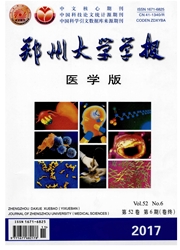

 中文摘要:
中文摘要:
目的:采用动物实验的方法评价自行研制的三嵌段材料PLGA-[ASP-PEG]与化学合成的骨形成蛋白2(BMP2)活性多肽复合物植入大鼠体内异位诱导成骨的能力。方法:成年雄性SD大鼠36只,背部消毒,切开皮肤,分离两侧肌间隙,按实验分为4组,按设计分别植入测试材料。A组BMP2活性多肽/PLGA-[ASP-PEG]复合物组;B组BMP2活性多肽/PLGA复合物组;C组单纯PLGA-[ASP-PEG]组;D组单纯PLGA组。将上述材料用环氧乙烷处理后植入大鼠背部肌肉中,分别于1周,4周,8周,12周和16周处死,进行植入物大体和组织学观察,并利用CT三维成像观察植入物成骨情况,应用荧光定量PCR检测Ⅰ型胶原(Col-Ⅰ)及骨桥蛋白(OPN)mRNA的表达。结果:组织学观察A组在8周出现新骨形成;B组在12周出现新骨;C组和D组16周未见新骨形成。CT三维成像16周时,A、B和C组均见新骨形成,骨块大小A〉B〉C组,D组未见新骨。实时定量PCR各组均有Col-ⅠmRNA和OPNmRNA的表达,A组Col-Ⅰ的Ct值为(21.67±3.21),OPN的Ct值为(21.72±5.11),与其他3组相比差异有统计学意义(P〈0.05)。结论:三嵌段材料PLGA-[ASP-PEG]及PLGA具有较轻的组织学反应,生物相容性好;BMP2活性多肽能明显诱导成骨;BMP2活性多肽/PLGA-[ASP-PEG]复合物具有较强的异位诱导成骨能力。
 英文摘要:
英文摘要:
Aim: To evaluate the eetopie osteogenetie capacity of BMP2-derived peptide combined with PLGA-[ ASP- PEG] by animal experiment. MethOds: A total of 36 SD rats were allocated into four groups. Group A: BMP2-derived peptide/PLGA-[ASP-PEG] complex. Group B: BMP2-derived peptide/PLGA complex. Group C: simple PLGA-[ ASP- PEG]. Group D: simple PLGA. The complex was respectively implanted into the back muscles of rats. At 1st, 4th, 8th , 12th and 16th week after implantation, the rats were killed, and the samples were harvested. The bone formation was detected by CT three diamensions imaging examination, and tissue response was observed by histology. Type Ⅰ collagen( Col- Ⅰ )and osteopontin (OPN) mRNA expressions were measured using real-time fluorescent quantitative polymerase chain reaction (FQ-PCR) technique. Results: Histological examination showed that in Group A, the cartilage was found around implant district 8 weeks after the implantation. In Group B, osteoblasts were seen at the 12th week, and in Group C and Group D, no new bone structure was found at the 16th week. FQ-PCR suggested that Col-Ⅰ mRNA and OPN mRNA were expressed in each group. In group A, Ct of Col-Ⅰ was (21.67 ±3.21 ), and Ct of OPN was (21.72 ±5.11 ), which were lower than those in other 3 groups (P 〈 0.05 ). Conclusion: Tri-bloek polymer materials PLGA-[ ASP-PEG] and PLGA have mild histological reaction with ideal bioeompatibility. BMP2-derived peptide can induce osteoeartilaginea process and BMP2-derived peptide/PLGA-[ ASP-PEG ] complex possesses more powerful capacity of inducing eetopic osteogenesis.
 同期刊论文项目
同期刊论文项目
 同项目期刊论文
同项目期刊论文
 期刊信息
期刊信息
